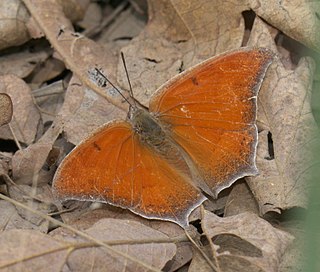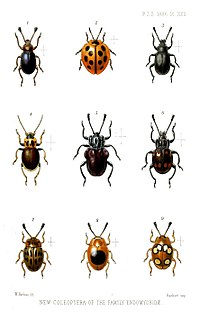
The acouchis are rodents belonging to the family Dasyproctidae from the Amazon basin. They are generally smaller than agoutis and have very short tails, while agoutis lack tails. For this reason the acouchis are also called tailed agoutis.

The white-throated kingfisher also known as the white-breasted kingfisher is a tree kingfisher, widely distributed in Asia from the Sinai east through the Indian subcontinent to the Philippines. This kingfisher is a resident over much of its range, although some populations may make short distance movements. It can often be found well away from water where it feeds on a wide range of prey that includes small reptiles, amphibians, crabs, small rodents and even birds. During the breeding season they call loudly in the mornings from prominent perches including the tops of buildings in urban areas or on wires.

The Encyclopedia of Life (EOL) is a free, online collaborative encyclopedia intended to document all of the 1.9 million living species known to science. It is compiled from existing databases and from contributions by experts and non-experts throughout the world. It aims to build one "infinitely expandable" page for each species, including video, sound, images, graphics, as well as text. In addition, the Encyclopedia incorporates content from the Biodiversity Heritage Library, which digitizes millions of pages of printed literature from the world's major natural history libraries. The project was initially backed by a US$50 million funding commitment, led by the MacArthur Foundation and the Sloan Foundation, who provided US$20 million and US$5 million, respectively. The additional US$25 million came from five cornerstone institutions—the Field Museum, Harvard University, the Marine Biological Laboratory, the Missouri Botanical Garden, and the Smithsonian Institution. The project was initially led by Jim Edwards and the development team by David Patterson. Today, participating institutions and individual donors continue to support EOL through financial contributions.
Isthmiade is a genus of beetles in the family Cerambycidae, containing the following species:
Isthmiade perpulchra is a species of beetle in the family Cerambycidae. It was described by Linsley in 1961.
Zikanita is a genus of beetles in the family Cerambycidae, containing the following species:
Zikanita perpulchra is a species of beetle in the family Cerambycidae. It was described by Lane in 1943.

Entomobrya is a genus of slender springtails in the family Entomobryidae. There are at least 60 described species in Entomobrya.
Stelis perpulchra is a species of insect in the family Megachilidae. It is found in Central America and North America.

Ozophora is a genus of dirt-colored seed bugs in the family Rhyparochromidae. There are more than 100 described species in Ozophora.
Peripsocus is a genus of stout barklice in the family Peripsocidae. There are more than 250 described species in Peripsocus.

Hoplitis is a genus of bees in the family Megachilidae. There are more than 380 described species in Hoplitis.
Tetraloniella is a genus of long-horned bees in the family Apidae. There are more than 100 described species in Tetraloniella.

Exechia is a genus of fungus gnats in the family Mycetophilidae. There are more than 180 described species in Exechia.

Atomaria is a genus of silken fungus beetles in the family Cryptophagidae. There are more than 160 described species in Atomaria.
Stylurus spiniceps, the arrow clubtail, is a species of clubtail in the dragonfly family Gomphidae. It is found in North America.
Eupompha is a genus of blister beetles in the family Meloidae. There are about 14 described species in Eupompha.

Mycetina is a genus of handsome fungus beetles in the family Endomychidae. There are about 11 described species in Mycetina.

Anaea andria, known generally as the goatweed leafwing or goatweed butterfly, is a species of leafwing in the butterfly family Nymphalidae. It is found in North America.
Eupompha elegans is a species of blister beetle in the family Meloidae. It is found in Central America and North America.












